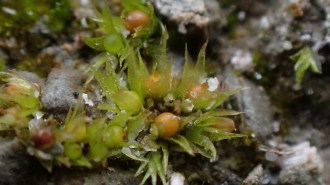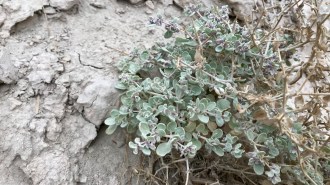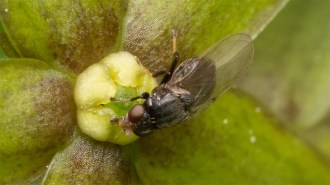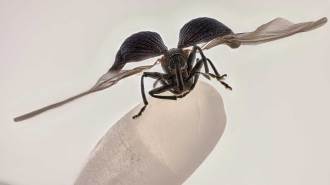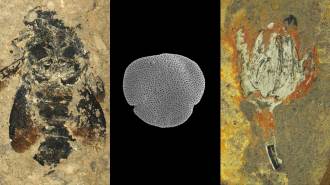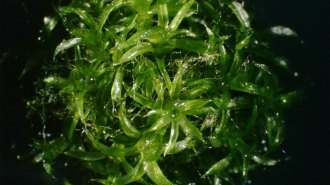Plants generally come across as the “good-luck-and-good-bye” type of mothers. They’re great at making baby clothes, wrapping their seeds in sophisticated coatings that keep away pests but let in spring rains. Plants also typically pack a good lunch for their little ones venturing out into the world. The fatty parts of coconuts, cashews, and peanuts are such good snacks that they appeal to youngsters of other species as well. But now biologists are discovering that some plants make unexpected investments that go beyond the physical characteristics of the seed.
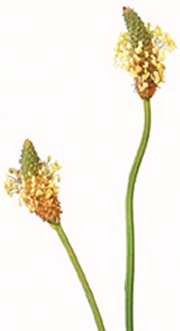

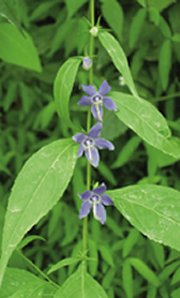
Plant mothers may regulate the temperature of their embryos, somewhat as a bird warms eggs in her nest. Other plants make investments that benefit their offspring after they sprout. Even after they’ve died, parents in several species continue to give their young a boost by providing a sheltering environment. Others prep their offspring in a botanical version of giving good advice to their young.
Such effects add new twists to scientists’ understanding of how plant evolution works. A youngster’s own genes and behaviors don’t always face the tests of natural selection on their own. Mom can radically alter the outcome.
Botanical brooding
Birds sit on their eggs to protect the developing embryos from chills, and recent evidence suggests that plants may do something similar. Elizabeth Lacey of the University of North Carolina in Greensboro is monitoring temperature in the mom plants that she studies.
Although potentially model mothers themselves, her subjects don’t appear on any Mother’s Day greeting cards. They are the plantain Plantago lanceolata, which is common in disturbed habitats and widely dismissed as a weed.
“Around here, they’re called shooters,” says Lacey. For several months of the year, the plant sends up stalks topped by a flower clump the size of a paperclip. When a playful child plucks a stalk, folds it into just the right kind of loop, and yanks, the bloom cluster breaks off and it shoots several yards. Undisturbed, the cluster stays on the plant.
The flowers in the cluster sport a sheath of pinhead-size modified leaves, or bracts, that carry varying amounts of brown pigment. When Lacey and David Herr, also of Greensboro, monitored local plants throughout a summer, they observed that the bracts of April flowers had more pigment than those of June flowers. Flowers grown at low temperature absorbed extra infrared light as well as visible light.
Temperature drives these color changes, Lacey and Herr report in the June American Journal of Botany. They grew plantains in a chamber under a chilly regimen, then harvested the stalks and dialed up the temperature. The bloom clusters that formed in warmth weren’t as dark as the chilled clusters had been, but when the researchers again cut off the stalks and then chilled the plants, they again produced darkened blooms.
Lacey and Herr report tests showing that temperatures inside the darker bracts rose 0.2°C to 2.6°C higher than those inside the lighter flower spikes did. Some lineages of plantain showed greater temperature differences than others did.
The researchers suggest that plantains warm their developing seeds during cool spells. “The question in my mind and the question in many people’s minds is, ‘Is this important?'” says Lacey. Will that boost from Mom give the lucky youngster an evolutionary edge, so that it will ultimately have more seedlings of its own?
The evidence so far is “suggestive” of such a boost, Lacey says. She and her colleagues are monitoring plantain offspring to see how temperature-controlled starts affect their survival and reproduction.
Extreme motherhood
Some plants seem to aid their offspring posthumously. Candace Galen says that she and Anna Wied discovered this effect in the 1990s, after the rigors of their field site started them thinking about plants’ parental care. Although based at the University of Missouri, Columbia, the two researchers spent summers in the Rocky Mountains at a site a little shy of 4,000 meters above sea level. There, wind blasts over big rock piles that bake during the day and get cold at night. “You’re always wondering how the organisms that live there can cope with all these things we find so oppressive,” Galen says.
On those rocky slopes, alpine thistles (Cirsium scopulorum) spend several years as low, slow growers. Then, the plants shoot up tall stalks of flowers, make seeds, and drop dead.
That’s not an unusual life history for plants growing in a forbidding place. The monument plant (Frasera speciosa), another flower of dry places, also builds up slowly to one flare of blooms.
Neither of these species has seeds with fancy adaptations for gliding away to a good growing site or snagging the coat of a passing animal. They just fall to the ground beneath Mom, who soon keels over on top of them.
In a year with typical rainfall, Wied and Galen’s alpine thistle and monument seeds germinated regardless of whether the researchers planted them on bare ground or on places scattered with parts of an adult plant.
However, once the seeds sprouted, the baldness of the ground determined what happened next.
Monument plant seedlings were almost twice as likely to survive if they grew among the fallen leaves and stems of an adult plant as they were if they grew in the open. And alpine thistle seedlings had four times the chance of living when fallen plant parts sheltered them (SN: 7/11/98, p. 20).
When Wied and Galen studied fallen plants, they found that soil under the collapsed mother plant was moister than that in open spots, where the sun and wind drove faster evaporation. The dead mother plant was thus providing postmortem drought insurance, the researchers claimed. They called this “one of the first demonstrations” of a plant nursing its own seedlings.
Galen says that before her work with Wied, few researchers had looked carefully at seedlings sheltered by their own kind. Earlier studies in other species had revealed that a seed often benefits from landing under a big plant of another species that shelters it during its tender youth. Such a bonus, called a nurse effect, had shown up in saguaro cactus seedlings, for example, that sprout in the shade of palo verde trees.
Good guidance
To see whether mother plants can give their offspring advice about how to cope with the environment, Laura Galloway of the University of Virginia in Charlottesville is studying tall bellflowers (Campanula americana). If seedlings generally sprout close to home, then they will probably thrive if their mother preps them for the same conditions that she’s experienced.
Bellflowers grow in forest shade or in gaps among trees. Their stalks bear starry blue flowers, and the female part of the flower curves out and up, like a miniature coat hook. A bellflower’s life in a forest gap differs greatly from life in the shade. Galloway has found that a bellflower basking in the sun of a forest gap in the morning gets some eight times as much light as a neighbor in the shade does. During the afternoon, the amount of light differs by a factor of 50.
Bellflower seeds have no gliding or hitchhiking powers, so initially they just drop to the ground. The researchers tested how far a seed travels on the ground. First, they sprayed bellflower seeds, which are less than 2 millimeters long, with fluorescent paint. Galloway’s crew scattered 400 of these seeds in each of several bellflower patches, some on flat ground and some on slopes. Two weeks later, the crew mapped the spots where the tiny seeds had ended up.
On flat terrain, they strayed only about 0.20 m from mom, and on the slopes, seeds had moved just 0.26 m. But in the Virginia woodland where the bellflowers grow, Galloway and her colleagues found that sunny patches are typically 12 m in diameter. Therefore, the light that shines on mom, be it dappled or dim, will probably shine on the seedlings too.
The Galloway team then checked to see whether bellflowers might preset a seed for its likely light regimens. The researchers pollinated plants to create genetically similar bellflowers. The researchers collected seeds from these crosses and planted them in the woods in either sun or shade.
A greater proportion of the seeds germinated in the same light regimen that their mothers had lived in than did in a different environment, Galloway reports in the April New Phytologist. Bellflower seeds from sunny moms were more likely to sprout in the sun, and seeds from shady moms excelled in shade.
The bellflowers seem to be programming their seeds for success in yet another way, Galloway says. In the woods, she has noticed that the sunny bellflowers are more likely to bloom earlier than the bellflowers in the shade bloom.
Those seeds from early bloomers tend to germinate soon, too, sprouting that summer and then blooming the next year. This annual lifestyle turns out to be a good strategy for making lots of seeds when plants have abundant resources, such as plenty of bright light.
In contrast, the seeds from late bloomers tend to germinate the next spring. They spend that whole next year as a nonflowering cluster of leaves and bloom in the following year. Evidence from other species suggests that an extra summer of growth may help plants make lots of seeds in light-poor places. So, Galloway notes, nonflowering summer growth may increase the fitness of seedlings of shade-growing plants. The researchers are currently testing that possibility and say the early results look promising.
The long view
Such maternal influence over young, beyond simple inheritance, was once treated as just a nuisance that could mess up genetics experiments, says Timothy Mousseau of the University of South Carolina in Columbia. In the late 1980s, though, biologists studying animals as well as plants began to examine the effects of moms’ experience on youngsters’ hardiness as interesting in their own right. “A bunch of us went out and looked for these maternal effects, and we found them wherever we looked,” says Mousseau.
In this new wave of interest in moms, mathematical modelers explored whether maternal influence could affect evolutionary outcomes. Natural selection works on the variation between individuals, but what happens when part of that variation comes from differences between what happened to their moms?
The models showed that, yes, moms’ influences reach into future generations. Depending on the circumstances, models showed, moms could make natural selection work extrafast, reverse direction, or flip a trait to one extreme in one generation and the opposite in the next.
So, as evolutionary biology goes, Mom has become a player.
